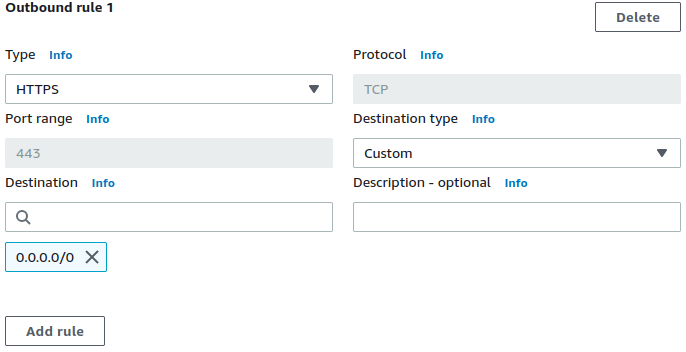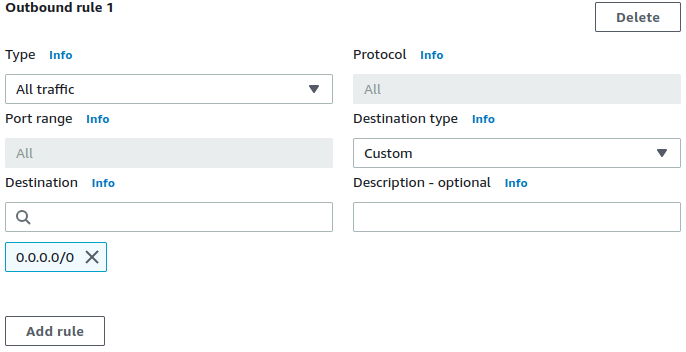DiscrimiNAT Firewall for egress filtering by FQDNs on AWS. Just specify the allowed destination hostnames in the respective applications' native Security Groups and the firewall will take care of the rest.
Architecture with ENIs in VPCs for Private Subnets' route table entries to the Internet.
DiscrimiNAT enforces the use of contemporary encryption standards such as TLS 1.2+ and SSH v2 with bidirectional in-band checks. Anything older or insecure will be denied connection automatically. Also conducts out-of-band checks, such as DNS, for robust defence against sophisticated malware and insider threats. Gets your VPC ready for a proper pentest!
- Creates ENIs, backed by instances in an Auto-Scaling group for high availability, for use as targets in route tables' destination
0.0.0.0/0(i.e. the Internet) entries. - Can accommodate pre-allocated Elastic IPs for use with the NAT function. Just tag allocated EIPs with the key
discriminatand any value. - VMs Or Lambdas (in VPC) without public IPs will need Security Groups with rules specifying what egress FQDNs and protocols are to be allowed. Default behaviour is to deny everything.
- A deployment per zone is advised, just like the AWS NAT Gateways – which are not needed with DiscrimiNAT deployed.
- VMs and Lambdas without public IPs will need to be in a subnet (typically the Private Subnet) with routing through the ENIs created by this module to access the Internet at all.
- You must be subscribed to the DiscrimiNAT Firewall from the AWS Marketplace.
If a Public IP is not found attached to a DiscrimiNAT instance, it will look for any allocated but unassociated Elastic IPs that have a tag-key named discriminat (set to any value.) One of such Elastic IPs will be attempted to be associated with itself then.
This allows you to have a stable set of static IPs to share with your partners, who may wish to allowlist/whitelist them.
The IAM permissions needed to do this are already a part of this module. Specifically, they are:
ec2:DescribeAddresses
ec2:AssociateAddress
An EC2 VPC Endpoint is needed for this mechanism to work though – since making the association needs access to the EC2 API. In the aws_vpc example, this is demonstrated by deploying the endpoint along with the VPC.
It is always possible to not choose this mechanism and have a Public IP associated with the network interfaces of the DiscrimiNAT right from the onset. This also used to be the case before v2.4 of the DiscrimiNAT.
- Understand how to configure the enhanced Security Groups after deployment, from our main documentation.
- Contact our DevSecOps at [email protected] for queries at any stage of your journey – even on the eve of a pentest!
Perhaps use the see-thru mode to discover what needs to be in the allowlist for an application, by monitoring its outbound network activity first. Follow our building an allowlist from scratch recipe for use with CloudWatch.
# This Security Group must be associated with its intended, respective application – whether that is
# in EC2, Lambda, Fargate or EKS, etc. as long as a Security Group can be associated with it.
resource "aws_security_group" "foo" {
# You could use a data source or get a reference from another resource for the VPC ID.
vpc_id = "vpc-1234example5678"
}
resource "aws_security_group_rule" "saas_monitoring" {
security_group_id = aws_security_group.foo.id
type = "egress"
from_port = 443
to_port = 443
protocol = "tcp"
# The DiscrimiNAT Firewall will apply its own checks anyway, so you could
# choose to leave this wide open without worry.
cidr_blocks = ["0.0.0.0/0"]
# You could simply embed the allowed FQDNs, comma-separated, like below.
# Full syntax at https://chasersystems.com/docs/discriminat/aws/config-ref/
description = "discriminat:tls:app.datadoghq.com,collector.newrelic.com"
}
locals {
# Or you could store allowed FQDNs as a list...
fqdns_sftp_banks = [
"sftp.bank1.com",
"sftp.bank2.com"
]
fqdns_saas_auth = [
"foo.auth0.com",
"mtls.okta.com"
]
}
locals {
# ...and format them into the expected syntax.
discriminat_sftp_banks = format("discriminat:ssh:%s", join(",", local.fqdns_sftp_banks))
discriminat_saas_auth = format("discriminat:tls:%s", join(",", local.fqdns_saas_auth))
}
resource "aws_security_group_rule" "saas_auth" {
security_group_id = aws_security_group.foo.id
type = "egress"
from_port = 443
to_port = 443
protocol = "tcp"
# Note that AWS does not allow multiple Rules with the same protocol/port/cidr combination, so
# we just choose a different network prefix to get around that. That is, if /0 had already been
# used, we'll pick /1 or anything uptil /32 really.
cidr_blocks = ["0.0.0.0/1"]
# Use of FQDNs list formatted into the expected syntax.
description = local.discriminat_saas_auth
}
resource "aws_security_group_rule" "sftp_banks" {
security_group_id = aws_security_group.foo.id
type = "egress"
from_port = 22
to_port = 22
protocol = "tcp"
cidr_blocks = ["0.0.0.0/0"]
# Use of FQDNs list formatted into the expected syntax.
description = local.discriminat_sftp_banks
}10 minutes after boot, at 0200 UTC every day and once at shutdown, each instance of DiscrimiNAT will collect its OS internals & system logs since instance creation, config changes & traffic flow information from last two hours and upload it to a Chaser-owned cloud bucket. This information is encrypted at rest with a certain public key so only relevant individuals with access to the corresponding private key can decrypt it. The transfer is encrypted over TLS.
Access to this information is immensely useful to create a faster and more reliable DiscrimiNAT as we add new features. We also aim to learn about how users are interacting with the product in order to further improve the usability of it as they embark on a very ambitious journey of fully accounted for and effective egress controls.
We understand if certain environments within your deployment would rather not have this turned on. To disable it, a file at the path /etc/chaser/disable_automated-system-health-reporting should exist. From our Terraform module v2.7.1 onwards, this can be accomplished by setting the variable ashr to false:
ashr = false

